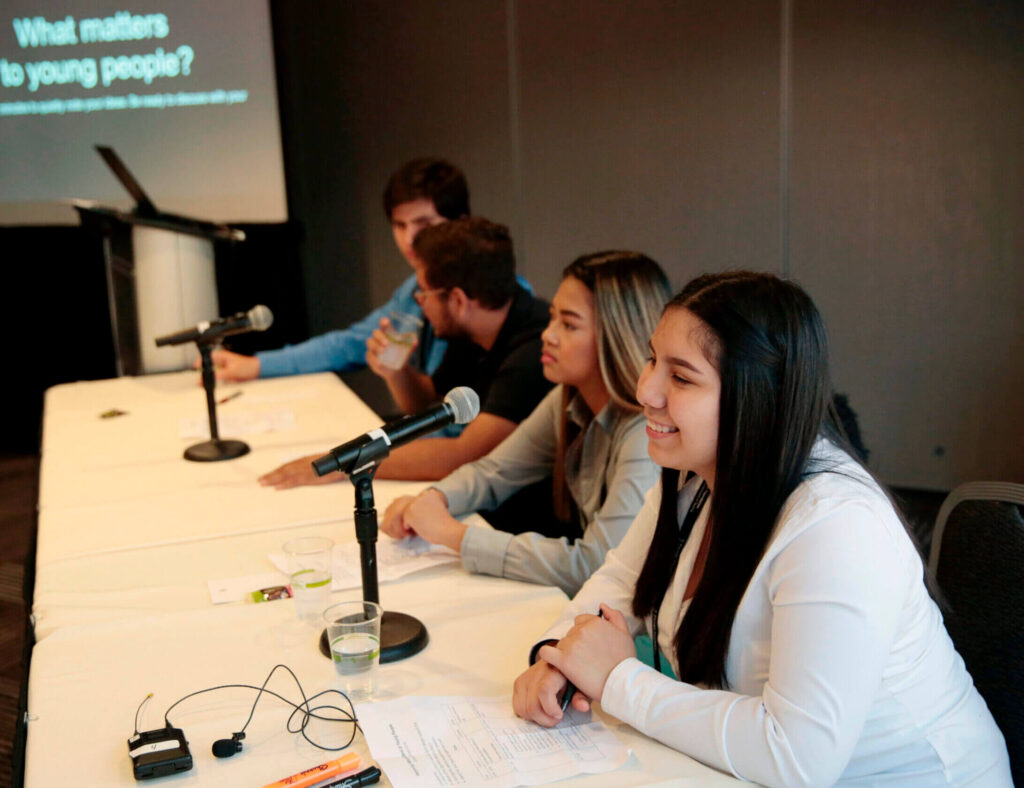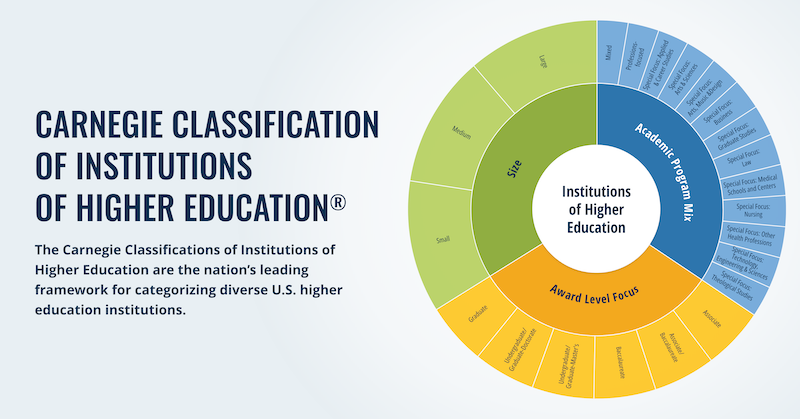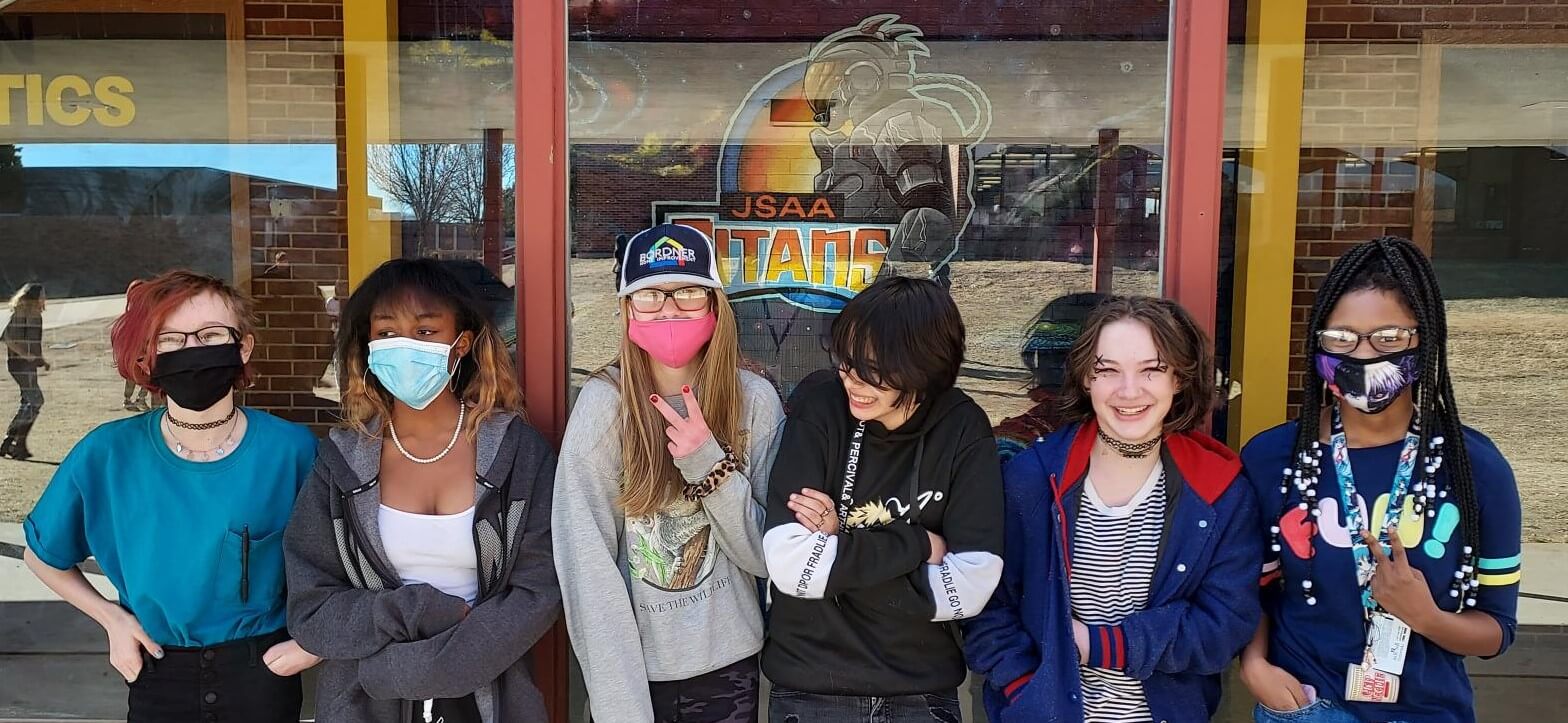On the Right Track: Fueling Student Success with Real-Time Data
Dan Carragher, principal of Jack Swigert Aerospace Academy in Colorado Springs, has a very simple leadership philosophy: “Do what’s best for students.” But, as he described to a full audience of educational improvers, doing what is best for students requires knowing how students are doing day-to-day. Relying on the traditional educational data toolkit of summative, end-of-year standardized assessments was insufficient in providing Dan and his leadership team with actionable data to make good on his student-focused leadership philosophy.
Students from Jack Swigert Aerospace Academy
In 2018, as a new principal, Dan realized he had no simple way of looking at student data to see quickly which students were doing well and which were not on any given day. It was hard to know what to do and for whom. To address this, Dan used excel to create a Tracker Tool to begin identifying all sixth, seventh, and eighth grade students’ key on-track indicators: attendance, course grades, behavior incidents, and social emotional indicators as determined by the district. Working with Talent Development Secondary (TDS) and referring to research, Dan set data thresholds to easily ascertain which of his middle school students were on-track to transition well into high school. He also created a protocol to help teachers monitor and use student data so that they could help students when, and if, they fell off-track. As a result of these efforts, one sixth-grade student who was failing all his courses early in the school year received timely attention and support from his teachers who were using the Tracker Tool. This student was able to make it to high school and thrive there; he was part of multiple leadership clubs and took three pre-AP courses.
The GRAD Partnership for Student Success
Dan shared this story alongside other improvement-focused school leaders during the Building Student Success Systems: How the GRAD Partnership is Changing On-Track Work Together session at the 10th Anniversary of the Carnegie Summit on Improvement in Education in April 2023. This session was designed by organizing members of the GRAD Partnership for Student Success, a collective effort on the part of nine different organizations who have put their stake in the ground by implementing high quality student success systems. The GRAD Partnership aims to make student success systems normal practice in high schools so that educators across the country, like Dan, can best support students with attainment. Formerly known as on-track or early warning systems, these next generation systems provide a comprehensive organizing structure for school communities to better support the academic progress, career and college transitions, and well-being of all students in locally relevant ways.
High-quality student success systems, as defined by the GRAD Partnership, include four essential elements:
- Strong, supportive relationships
- Real-time, actionable, and holistic data
- Strategic improvement actions
- Student-centered mindsets
By focusing on relationships, actionable data, and evidence-based practices, student success systems, like Dan’s, help educators and communities build a sense of belonging and school connection among students, address school-wide achievement patterns, and meet individual student needs.
Research Supports Importance of On-Track Indicators
There is a large body of research that signals how on-track rates to on time graduation in high school are some of the most actionable data at educators’ disposal. In fact, research shows that on-track data in ninth grade (calculated based on attendance, behavior and GPA) is the single best predictor of whether a student will graduate from high school within four years—more so than prior test scores, family income, or race/ethnicity.

And while ninth grade is indeed a pivotal year for students, more schools and districts across the country are turning their attention to on-track rates in middle school, seeing that a student’s attendance and GPA in elementary and middle school are also important indicators of student success in high school and in post-secondary readiness. In fact, research suggests that third through eighth-grade students who were considered on-track (with an attendance rate at or above 90% and a GPA at or above 3.0) graduated high school at more than twice the rate of students with a less than 90% attendance rate and a less than 3.0 GPA.
Continuous Improvement Fuels Student Success Systems
What makes the use of on-track indicators, such as attendance, GPA, and behavior, so powerful is their application in strategic improvement actions like cross-subject teacher meetings or iterative testing of interventions that are supported by coaches, frameworks, and protocols. Responding with improvement practices enables teams of educators who share students in common to work collectively to co-design and adapt evidence-based solutions that are maximally relevant in their local contexts.
We turn to continuous improvement because it promotes collaborative problem-solving to change system processes, practices, and outcomes. This principled approach challenges leaders to make the work user-centered and problem-specific; it helps teams solve for variation, see the system that creates current conditions, anchor practice in disciplined inquiry, and use measurement so that they can tell whether changes are, in fact, improvements that they were intended to be. Using this approach allows educators to know what works and how to get good ideas to work well for more students. Continuous improvement brings together the methods and mindsets necessary to power student success systems. At the Carnegie Summit on Improvement in Education, we hear many stories about continuous improvement practices that have led to improved student outcomes and increased educators’ sense of efficacy with making impactful changes.
An Example in Chicago: The Middle Grades Network
“We have to be intentional with the support we provide, so that [students] can and do change.”
Ashley N. Leonard
Associate Director, Middle Grades Network
One story of implementing student success systems at various school sites comes from work in Chicago. At the Carnegie Summit, Ashley N. Leonard and Jennifer Ciok from The To&Through Project, based at the University of Chicago, presented stories from the Middle Grades Network (MGN), a cohort of fourteen middle and elementary schools across the city of Chicago that are working to improve student success by focusing on elementary on-track rates (EOT).
For example, John B. Drake Elementary School, an inaugural MGN cohort member, joined the network with an aim to increase the number of students with an attendance rate at or above 90% and a GPA at or above 3.0 through a meaningful increase in students’ sense of belonging.
Similar to schools across the network, Drake Elementary utilized a combination of qualitative data strategies such as empathy interviews, focus groups, student shadows, and surveys to better understand their students’ experiences at school. By looking at this data in combination with EOT on-track data (attendance and GPA), Drake Elementary educators designed and tested various change ideas to support their students better.
According to Christopher Robbins, principal of Drake Elementary, their change idea related to one-on-one student conferences had a significant impact on students’ on-track rates and on building meaningful relationships. By leveraging EOT data and a belonging map protocol, the team at Drake Elementary with support from the MGN team held conferences with every middle grades student, striving to better understand their needs.
After implementing these conferences, Drake saw a 9% increase in on-track rates (SY 2021-22). Drake Elementary also saw a 5% increase in teacher caring on the Elevate survey, including increased empathy from teachers and a shift in mindsets, as teachers reported more willingness to meet students where they are. Now, Drake Elementary holds one-on-one student conferences three times a year with every student and tests other change ideas that the school has implemented, thanks to the information gathered from EOT on-track and other student experience data. Drake Elementary’s story is one example of how on-track data and continuous improvement practices can be used to improve student outcomes and on-time high school graduation.
“We really want to help our schools have a better idea of what their students are feeling when they’re at school.”
Jennifer Ciok
Coach, Middle Grades Network
A Call to Action
Celebrating impact and joining forces is what brings improvers to the Carnegie Summit on Improvement in Education and is also what is needed for us to spread and scale what we know is best for students.
The impact of graduating from high school ready for college is unambiguous. The most persuasive research in the social sciences draws straight lines between secondary and post-secondary completion and longer lifespans, better health outcomes, increased lifetime earnings, reduced incarceration rates, more frequent participation in democratic and civic activity, and having children with higher levels of educational attainment. At the Carnegie Foundation, we know that improving educational attainment is instrumental to the nation’s health, economy, democracy, and social fabric.
That is why we at the Carnegie Foundation are committed to increasing the number of underrepresented students nationwide who graduate high school with purpose and are ready to succeed in a variety of post-secondary opportunities. The GRAD Partnership represents a unique opportunity to learn collectively, elevate continuous improvement practices,and integrate evidence-based solutions so that they are locally relevant and maximally impactful. The GRAD Partnership offers tremendous expertise, thought leadership, and the research acumen of leading organizations in the field to support educators across the country, like Dan and the team at Drake Elementary, with implementing, improving, and innovating student success systems. We know that we can accomplish more together than even the best of us can accomplish alone.
To join the GRAD Partnership’s effort, you can sign up for the mailing list.
August 3, 2023
The Council of Chief State School Officers’ new report, Imagining More: How State Education Agencies Can Modernize the K-12 Education System to Put Student Learning at the Center, is out now with recommended actions that state leaders can take at a systems level to make way for this transformation, including…
August 17, 2023
Dr. Valeria Brown, Carnegie Foundation’s Future of Learning Director, challenges old ideas of professional learning in the Learning Forward Journal’s August issue. In her piece, “Professional Learning Isn’t About Hours”, Dr. Brown raises a critical point about the outdated Carnegie Unit. Originally established in 1906, the credit hour measures student…








